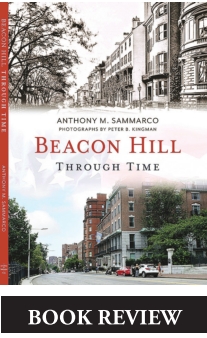Now that the weather is mild, pick up a copy of Anthony M. Sammarco’s latest richly illustrated history book, Beacon Hill Through Time. The 96-page work, on high-quality paper, is available from Arcadia Publishing at a list price of $23.99.
The book, with a mix of Peter B. Kingman’s expertly composed photos and a multitude of archival pictures, may surprise a lot of people.
Consider, for instance, how relatively late much of Beacon Hill was developed, considering that Boston was founded in 1630.
The Hill’s South Slope didn’t become the famously upscale residential area that people think of now until well after 1800, as the new wealth from the China Trade and other shipping, followed by fortunes made in manufacturing and finance, paid for grand mansions, brick and stone row houses and private clubs and other institutions.
There were some teardowns on the South Slope of a few older houses, most notably John Hancock’s mansion, built in the 1730’s and destroyed in 1863 to make way for an addition to the glorious Charles Bullfinchdesigned Massachusetts State House (completed in 1798) at the top of the Hill.
Bullfinch, as architect and developer, is the father of Beacon Hill.
It’s
basically a creation of the 19th Century, when the American public
began to associate the hill (and then also the Back Bay) with the
mercantile aristocracy to be called the “Boston Brahmins’’ I was
surprised to learn that many buildings I had thought were built in the
late 18th or early 19th Century are actually decades newer.
Architects
have heavily used Colonial Revival and Federalist and 18th and 19th
Century London residential styles right up to the present to maintain
Beacon Hill’s antique appearance.
Consider
West Hill Place, where, Sammarco notes: “The design of these houses –
with their high-style neoclassical details… made it seem as if London
had been transplanted in Boston.’’ Then, as Sammarco explains, there
were the waves of ethnic groups moving on and off the Hill, along with
various religious, political and other movements.
For
example, an African- American community developed early on the Hill’s
North Slope that created their own religious and other institutions as
did various Eastern European and other immigrants who followed.
These
flows led to such changes as, for example, a Black Baptist church being
transformed into synagogue. Meanwhile, shops changed with neighborhood
demographics as well as with the evolution of the broader consumer
society.You’ll see in the book how big, high-rise business buildings
replaced lovely residential sections, sad but reflecting Boston’s
wealth-creating capacity. Consider the elegant Pemberton Square before
commerce took it over, late in the 19th Century.
Many
direct most of their attention to the sights on the Hill itself; for
example, Louisburg Square, rather than to the “Flat of the Hill’’ down
by the Charles River and created by using fill from chopping off the
tops of Beacon, Mt. Vernon and Pemberton hills (the “Tremonts’’).
There
are some gorgeous areas there, too, such as Charles River Square. So
you’ll probably want to plan several explorations with Sammarco’s book
in hand.